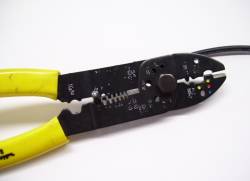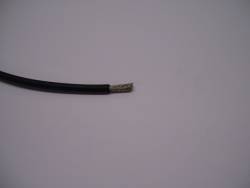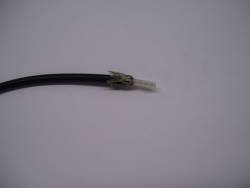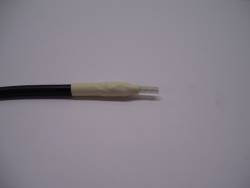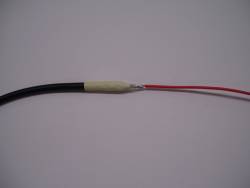Table of Contents
Working with Coaxial Cable
Coaxial cable is a type of electrical cable consisting of an inner conductor, surrounded by a concentric ring of insulation and a conductive sheath. SymTech Labs' customers most frequently encounter coaxial cable, used as “shielded cable,” in SymTech Labs' Premium Megasquirt Wiring Harnesses. The coaxial cable in Premium Megasquirt Harnesses delivers the signal from the crankshaft angle sensor to the Megasquirt ECU while shielding it from electromagnetic interference. It is important to properly terminate this cable to prevent loss or absence of signal or unwanted ground loops.
Stripping the Outer Insulating Jacket
The outer insulating jacket must be stripped carefully in order to prevent damage to the conductive sheath. Automatic wire strippers are not recommended for stripping this portion of the cable. Instead, use manual strippers, beginning with the largest notch and using progressively smaller notches until the jacket is neatly cleaved. Refer to our article on stripping and soldering wires for more information about using manual strippers.
Securing the Conductive Sheath
It is imperative that the conductive sheath of the coaxial cable be left electrically isolated. If the sheath is grounded, potentially hazardous ground loops can form. If the sheath establishes contact with the inner conductor, partial or complete loss of signal will occur.
Once the outer jacket is stripped from the cable, carefully pull the sheath back upon the cable, exposing the intermediate insulator and inner conductor.
Secure the sheath using heat shrink tubing or dielectric/“electrical” tape to fully isolate it.
Joining the Inner Conductor
Once the conductive sheath is secured, strip the intermediate insulator from the exposed portion of the inner conductor. The intermediate insulator is generally made from polyethylene (PE) or polytetrafluoroethylene (PTFE), both of which are more difficult to puncture than standard polyvinyl chloride (PVC) wire insulator. As such, manual wire strippers, as opposed to automatic wire strippers, are recommended for stripping the inner conductor.
Solder the exposed inner conductor to the the signal's source (i.e. a crankshaft angle sensor's signal wire).
Refer to our article on stripping and soldering wires for more information about using manual strippers and soldering.
